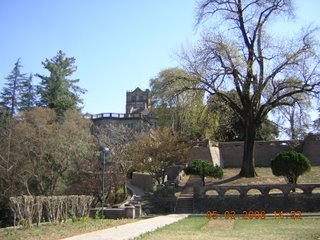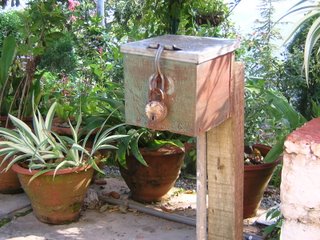Why this blog is called "Gallimaufry".
gal-uh-MAW-free\, noun.
Originally meaning "a hash of various kinds of meats," "gallimaufry" comes from French galimafrée; in Old French, from the word galer, "to rejoice, to make merry"; in old English: gala + mafrer: "to eat much," and from Medieval Dutch maffelen: "to open one's mouth wide."
It's also a dish made by hashing up odds and ends of food; a heterogeneous mixture; a hodge-podge; a ragout; a confused jumble; a ridiculous medley; a promiscuous (!) assemblage of persons.
Those of you who know me, will, I’m sure, understand how well some of these phrases (barring the "promiscuous" bit!) fit me.
More importantly, this blog is an ode to my love for Shimla. I hope to show you this little town through my eyes. If you don't see too many people in it, forgive me, because I'm a little chary of turning this into a human zoo.
Stop by for a spell, look at my pictures, ask me questions about Shimla, if you wish. I shall try and answer them as best as I can. Let's be friends for a while....
31 May 2006
Numbers, mere numbers!
103 tunnels between Kalka & Shimla.
2 little Tibetan monasteries at Sanjauli & Kasumpti.
7 Hills:
- Elysium , where Auckland House school and Longwood, a housing estate, are located.
- Inverarm: You have to huff and puff up a steep little road to reach the State Museum on the Chaura Maidan (which is neither "chaura" nor a "maidan" !). Do look out for Chaura Maidan's tiny and utterly winsome post office at the foot of the hill. The Museum is open between 10 a.m. & 5 p.m. and is closed on Monday and public holidays.
- Jakhoo is Shimla highest peak and is best known for its monkeys & the temple dedicated to Hanuman (the monkey god from the Hindu epic Ramayana. The best way to access this is from the Ridge on foot, but you can also drive up.
- Bantony (the location of the crumbling Grand Hotel.
- Prospect Hill offers a splendid view if you're ready to walk for just 15 minutes beyond the suburb of Boileauganj. The Kamna Devi temple is also located here.
- Summer Hill has to have one of the prettiest little railway stations in India. Trundle down the hill and you may yet chance upon an Arcadian vision!
- Observatory Hill is home to the Viceregal Lodge. Enough said.
30 May 2006
A special word of thanks.
Such is the wonderful world of internet: two complete strangers meet anonymously on a bulletin board & a collaboration happens.
More flowers

Magnolia. (Magnoliaceae).
A genus of 80 species of hardy evergreen and deciduous flowering trees and shrubs. It contains some of the most spectacular speciment trees and shrubs.
The magnolia shown in this picture may be Magnolia sieboldii, syn. M. parviflora, found in Japan or Korea. Height and spread 10-15 feet. The pendent, bowl-shaped flowers, 3in across, are white with conspicuous claret stamens. OR it could be
Magnolia x soulangiana. Height 10-15 ft; spread 10-18ft. White, chalice-shaped flowers, 5-6in across and stained rose-purple at the base, open in April before the leaves unfurl. Of Japanese origin.

Jasminum. Jasmine (Oleaceae).
A genus of 300 species of tender and hardy, deciduous and evergreen shrubs and climbers. They are suitable as ground cover on rock gardens , for training against walls or fences or for twining over arbours, trellises and pergolas.
Jasmine flowers are tubular, opening out salviform; they are usually borne in terminal and axillary clusters, sometimes forming panicles. Some species are strongly fragrant. The leaves are opposite and in most cases, pinnate.
These varieties are yellow – J. mesnyi, syn. J. primulinum (primrose jasmine). China. Height up to 10 ft and J. nudiflorum (winter-flowering jasmine). China. Height up to 10 ft.
This picture is probably of J. parkeri (N.W. India). Height 8-12 inches (sic). A hardy, dense, hummock-forming evergreen shrub with pinnate leaves. Yellow.
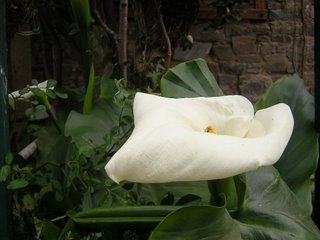
Zantedeschia. (Araceae).
A genus of eight or nine species of rhizomatous, perennial, half-hardy and tender greenhouse(!) plants. The flowers are borne on a spadix at the end of a long stem and surrounded by a large spathe. Forms of Zantedeschia aethiopica may be grown out of doors in mild districts in UK.
This picture is that of an Arum Lily (Zantedeschia aethiopica). From South Africa. A deciduous species with mid to deep green, slightly glossy, arrow-shaped leaves. White spathes, 5-9inches long, surrounding a conspicuous yellow spadix are borne from March to June.

Wisteria (Leguminosae).
A genus of ten species of hardy deciduous climbing shrubs. They are among the most beautiful of all climbing plants and are used to decorate walls, fences, arches, pergolas and trees.
The flower could be either : (1) Wisteria sinensis (Chinese wisteria). Height up to 100ft. This large species is the finest and most popular of the wisterias. The dark to mid-green leaves consist of up to eleven leaflets which makes the species easily distinguishable from (2) Wisteria floribunda. Dense, 8 to 12 inch long racemes of fragrant mauve flowers are freely produced. Wisteria sinensis ’Alba’ has white flowers; Wisteria sinensis ‘Plena’ has double mauve flowers.

This is a species of camellia.
17 May 2006
Shimla's flowers
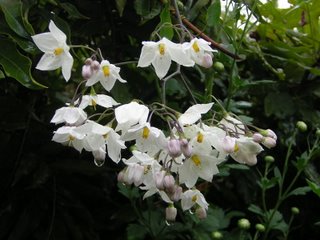
Sweet William (Solanum jasminoides Alba) Originally from Chile, this beautiful plant is a member of the Sol olanaceae family and is related to the humdrum potato and aubergine.
Thanks, Maeve, for the above information.

I am now reliably informed that this plant is not Primula veris, but a variety of camellia.
Let's keep the following poem anyway!
The primrose moments, lush with bliss,
Exhale and fade away
15 May 2006
Coming soon on this blog
(As soon as the author is able to identify the flowers she has so assiduously photographed!)
The Viceregal Lodge
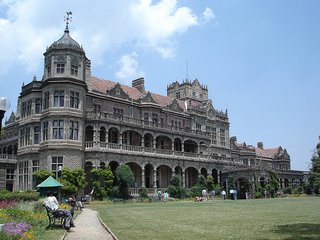
The sight of the Viceregal Lodge is splendidly refreshing when you first huff and puff your way up the Observatory Hill.

What is the most amazing thing about this builiding for me? The fact that it was desgined and built by the Public Works Department (PWD). The same PWD which has become synonymous with the uniformity of its buildings' ugliness and whose bridges are reknowned for the regularity with which they crumble at the smallest opportunity!
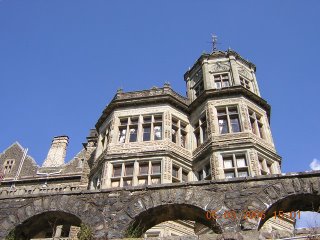
But let's focus on Viceregal Lodge. Grand spiralling staircase. A larger-than-large fireplace. Massive wine cellar. Grand teak-panelled rooms. Majestic turrets. Huge kitchens. Dozens of galleries, verandahs and terraces. Mammoth chandeliers. Little bunkers from the two world wars. This must have been quite a place in the days when the Viceroy of India occupied it.

In the late 1800s, this was the only building with electricity and central heating in all Shimla.

This is the place where the decision was made to partition India.
Today, it houses Institute of Advanced Studies.

8 May 2006
The 'other' Yarrows

This aromatic, lacy-leaved plant is topped with a flat head of small flowers. It was once used for colds and as a tonic.
In the ancient times, Yarrow was used medicinally to staunch wounds & stop bleeding. It was sacred to the god Ares, & was in particular associated with the godlike warrior Achilles, for whom the genus "Achillea" is still named. It was said to have sprung from the rust Achilles scraped from his spear to heal a centaur fallen in battle, whom Achilles himself had injured.
Its association with warriors continued through the ages, so that it has been known by such names as Soldier's Woundwort, Staunch Weed, Military Herb, Knyten or Knight's Milfoil, Militaris, & was carried by soldiers into battle to insure courage & magical protection from being wounded at all.
I found two old English verses related to this flower...
If my love loves me, 'twill bleed every drop.
In the name of Jesus Christ, I pluck it from the ground.
As Jesus loved sweet Mary & took her for his dear,
So in a dream this night, I hope my true love will appear.
Lastly, A tonic of Yarrow tea if taken within a church was supposedly a great cure for demonic possession.
Ahem...!
Yarrows

Home to several generations of officers from the Indian Audit and Accounts Service, Yarrows was probably so christened by a very homesick Scotsman! The genesis of this building is shrouded in mystery, but its current and former inhabitants are fond of claiming that it was constructed in the 19th century, was home to the Finance Secretary to the Viceroy of India and sometime summer residence of the Jinnah family. The first resident was someone called Lowndes and the architect Sir Herbert Baker.
The original Yarrows lies in Inverness, the Loch of Yarrows being somewhere close to the town of Wick. The name Yarrows is thought to come from the Norse 'Yar-howe' meaning 'mound of the fish-traps'...
5 May 2006
Waxing lyrical is all very well...
Trains between Delhi & Kalka:
- 2005 Kalka Shatabdi. Leaves New Delhi at 17:15. Arrives in Kalka at 21:15. Runs on all days of the week.
- 2011 Kalka Shatabdi. Leaves New Delhi at 07:40. Arrives in Kalka at 12:00. Runs on all days of the week.
- 4095 Himalayan Queen. Leaves Hazrat Nizamuddin Station at 05:05. Arrives in Kalka at 11:20. Runs on all days of the week.
- 2925 Paschim Express (This train runs between Bombay's Bandra Terminus & Kalka). Leaves Hazrat Nizamuddin Station at 10:08 Arrives in Kalka at 16:05. Runs on all days of the week.
- 2311 Howrah-Delhi Kalka Mail. Leaves old Delhi station at 2140 Arrives in Kalka at 04:40. Runs on all days of the week.
Fares:
1. First class air-conditioned (AC) on Shatabdi: Rs. 880.
2. First class air-conditioned (AC) on Howrah-Delhi Kalka Mail: Rs. 995.
3. AC chair car: Rs. 445.
4. Second seating: Rs. 97.
5. Second AC: Rs. 580.
6. Third AC: Rs. 411.
7. Second sleeper: Rs. 177.
8. Second seating: Rs. 96.
Note:
Options no. 5, 6, 7 & 8 are available only Howrah-Delhi Kalka Mail.
Options no. 6 & 7 on are available only on Pashim Express.
Or, the fun bit.
- 1KS Kalka Simla Passenger Train. Leaves Kalka at 04:00. Arrives in Simla at 09:20. Runs on all days of the week.
- 241 Shivalik Deluxe Express. Leaves Kalka at 05:30. Arrives in Simla at 10:15. Runs on all days of the week. (Fare includes tea & breakfast charges). This is a great option if you have time on your hands and would like a nice slow journey.
- 251 Kalka Simla Express. Leaves Kalka at 06:00. Arrives in Simla at 11:00. Runs on all days of the week.
- 255 Himalayan Queen. Leaves Kalka at 12:10. Arrives in Simla at 17:20. Runs on all days of the week.
Fares:
1. First class (only available on 1KS Kalka Simla Pasenger): Rs. 189.
2. AC chair car (only available on Shivalik Deluxe Express): Rs. 280.
3. First class (only available on 251 Kalka Simla Express): Rs. 228.
4. Second seating only available on 251 Kalka Simla Express): Rs. 51.
5. Ac chair car (only available on 255 Himalayan Queen): Rs. 167.
You can post further queries on this blog. I shall atempt to answer them as best as I can.
IRCTC allows you to book tickets on-line.
Cleartrip offers very user-friendly options for booking train tickets.

